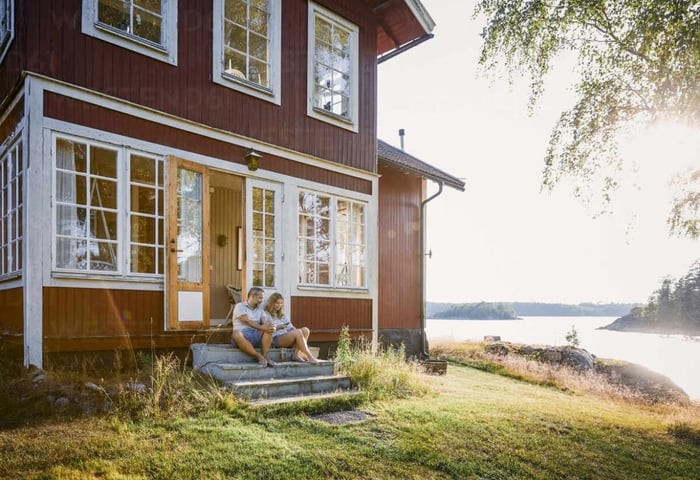Summer is officially over, and those of us who enjoy warm sunny days at coastal or upstate summer cottages have to move closer to central heating and more solid concrete housing. But can you just hand the lock on your summer house and expect it to be just the way you left it once you come back in Spring? Unfortunately, not!
Especially if we are talking about waterfront properties and those located at a mountainous terrain, summer houses are highly vulnerable to floods, mudslides, extreme temperatures, elements, and other inevitable companions of the season change.
Eventually, many people are lucky to find their summer cabins at the same place where they have left them if they don`t seal and protect them adequately.

In this article, we shall talk about how you can seal your summer cottage from floods and other possible natural disasters to ensure that your next vacation won`t start with estimating the damage and filing the insurance claims.
Refresh wood treatments
Cabins and summer houses made of wood are most vulnerable to water damage, extreme temperatures, and UV light. And, of course, don`t forget about insects, which are among the primary reasons the overall structure may become unstable and require some pretty costly repairs.
Wood treatment is a crucial step if you want to seal your summer house for winter properly. Even if winters are not that harsh in your region and massive floods, rainfall, or extreme temperatures are not really an issue, experts recommend treating your wood with unique products at least once a year to preserve natural oils and prevent cracking.
Needless to mention that wood treatment should be done in warm and dry weather.

Provide proper ventilation
Fresh air is crucial for our health. In fact, it might be the primary reason why you got yourself a summer house or cabin in the woods.
However, the house itself needs fresh air, not less than people who spend time in it. Therefore even though it might seem reasonable to seal all windows and doors when you leave for the season, lack of ventilation can be a real problem for the cabin`s structure.
Whether the area gets flooded or not, moisture from the air will condense on all surfaces as the temperatures change. Once the ventilation in your summer house is poor, the stale air becomes an incubator for mold, fungus as well as bacteria, and even insects who will inevitably destroy wooden structures.
Make sure that air can circulate freely through the attack window or under the deck of your summer house. Clear all the debris or excessive greenery that can prevent circulation. Ensure that there is no space under or inside the house where water can collect and stale, becoming the powerful air moisturizer.
Check the roof and the gutters.
Heavy rainfall is one of the primary reasons why your summer house or wood cabin can be damaged by water. Make sure to check the roof thoroughly before you leave and eliminate all cracks, dents, or rotten parts.
It is also essential to check the gutters and make sure there is no debris, birds nests, or other obstacles left there, so water can pass freely without stalling on the roof.
Suppose the summer house or wood cabin is located in an area famous for its snowy winters. In that case, it is essential to make sure that roof and gutters are able to withstand the weight of snow from the very beginning and can conduct the water from snowmelt away from your property freely and efficiently.
It might also be an excellent idea to visit your cabin in the winter from time to time and clear snow from the roof and around the property. This measure will significantly minimize the risk of flooding as soon as the temperatures rise, but the ground will still be too frozen to soak all the excessive water.

Seal windows and all passages
Once your summer house or cabin is located in the coastal area or next to lakes, rivers, etc., there is a strong chance that your property will get flooded at least once while you are away.
Sometimes the floods are pretty minor, and most of the moisture manages to dry out even before you arrive next summer. That is why many people don`t even suspect that their summer houses and wood cabins get flooded in winter.
However, in many cases, the consequences of water damage such as mold, fungus, and rot reveal themselves at the moment, then the repair will be most painful and expensive. These water damages are most common for wooden constructions. However, they are the same dangerous and costly for all kinds of buildings and households.
Sealing your property against floods and water damage is essential. There are several ways to do so:
- Make sure that all windows and doors, as well as basement and garage passages, are sealed properly, don`t have any cracks and damages that can worsen due to change of temperature;
- Use special window tape to secure windows from excessive moisture;
- go through the whole building and make sure to fill all the cracks that you manage to find with silicone;
- If you find any signs of water damage and leak before sealing the summer house, address them immediately. Otherwise, they can worsen during the winter and result in massive damage and costly repair next season.
Installing flood barriers at your summer house is the most efficient and straightforward way to protect it from floods and water damage during the winter.
Dam Easy Flood Barriers are easy to deploy and remove. They adapt to the measurements of each passage and seal it thoroughly, preventing even the most minor leaks.
Contact Dam Easy right now and learn about our flood barriers and other solutions that will help you seal your summer house or wood cabin, giving you please of mind and confidence that in the Spring, you will return to a dry, safe and cozy summer house for new lifetime memories.
Flood Barrier Door Dam - Ultimate Flood Gate

$1,260.00
DAM EASY® FLOOD GATE - DOOR DAM Floods are becoming more common around the world. What was once a 100-year phenomenon is now a seasonal trend that homeowners must deal with. That’s EXACTLY why you need this Dam Easy Flood… Read More



